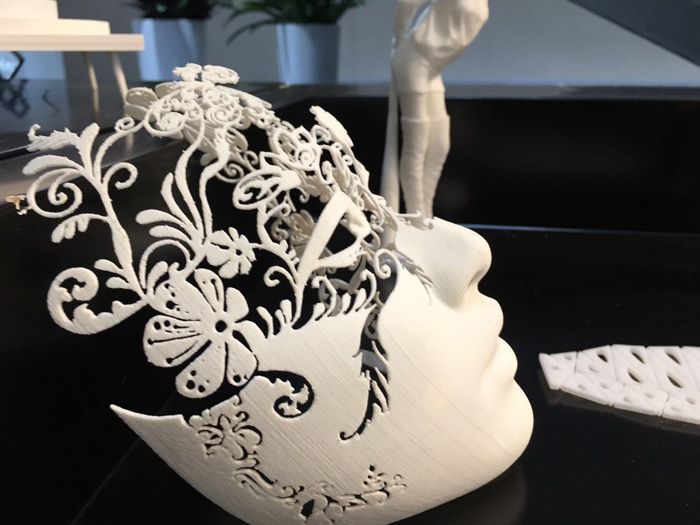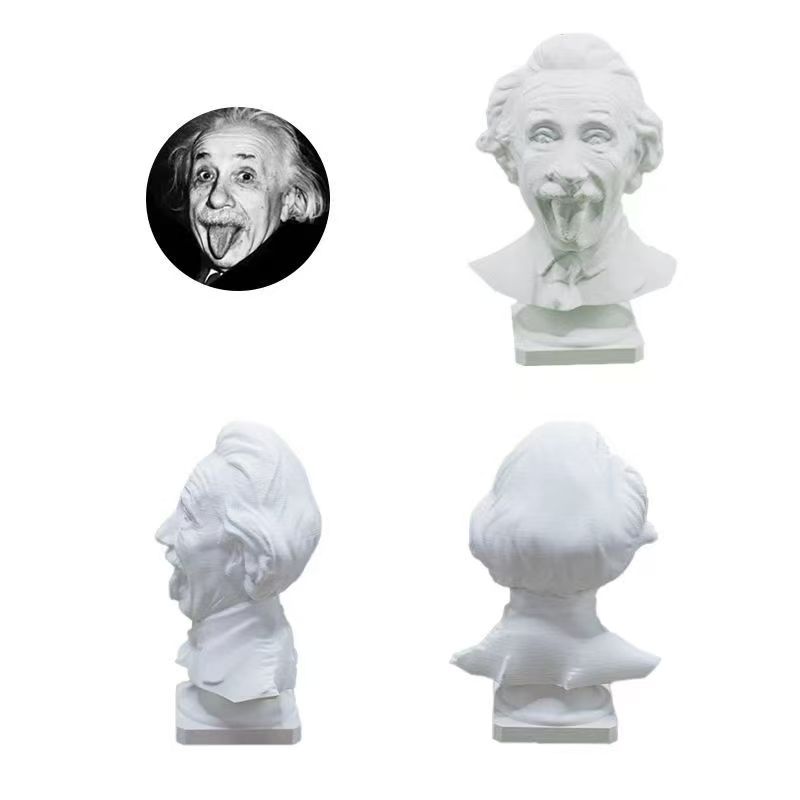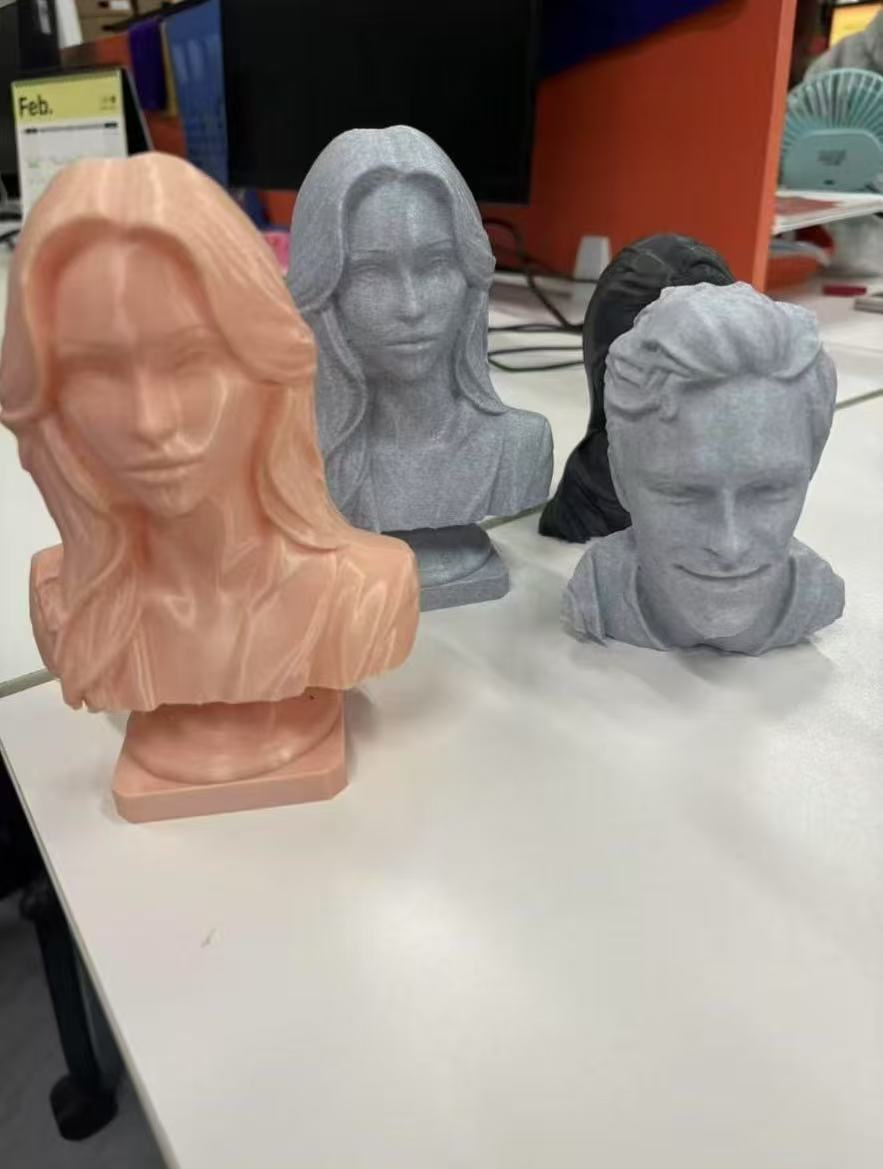- 1. The five core advantages of 3D printed sculptures
Unparalleled creative freedom
Traditional sculpture is limited by the physical limitations of hand-carving, while 3D printing technology can accurately achieve complex geometries, hollow textures, and even dynamic fluid forms.
Complex design: Topology-optimized structures or fractal patterns that are difficult to achieve with traditional tools can be easily made;
Digital Native Art: Combining algorithm-generated designs (e.g., parametric modeling) to create surreal forms that do not exist in nature;
Mixed media: Combine with electronic components, lighting, or mechanical devices to create dynamic and interactive sculptures.
Efficient production and rapid iteration
Shorten the cycle: from the digital model to the physical finished product, there is no need for mold making, which greatly reduces the manual time of traditional sculpture for several months;
Low-cost trial and error: Artists can quickly print small-scale prototypes, verify the design, and then make large-scale works;
Mass customization: Multiple copies of the same digital file can be quickly generated, suitable for limited edition artwork or commercial exhibition needs.

Diversity of materials expands artistic expression
3D printing supports a wide range of materials such as metals, resins, ceramics, bioplastics, and even concrete:
Metal sculpture: industrial-grade printing of titanium alloy and stainless steel, suitable for large-scale outdoor installations;
Transparent resin: creates a light and shadow effect with a glass texture;
Eco-friendly materials: degradable PLA plastic or recycled materials, in line with the concept of sustainable development.
Precise reproduction and cultural heritage protection
Cultural relics restoration: 3D scanning of damaged sculptures, digital restoration and printing of missing parts (such as the Parthenon statue restoration project in Greece);
Artistic inheritance: reproduce the master’s works for educational display, and avoid the risk of transporting the original works.
Personalization and popularization of art
Private customization: generate portraits, sculptures or souvenirs based on user data;
Democratizing art: Lowering the barriers to entry for creation and enabling independent artists and small studios to achieve high-precision work.
- Second, the application prospect of 3D printing sculpture
Public Art & Cityscape
Large-scale installations: lightweight metal structures that reduce transportation and installation costs (e.g., a 20-metre-tall futuristic sculpture printed in Dubai);
Interactive art: combining sensors and projection technology to create intelligent sculptures that respond to the environment;
Temporary exhibitions: Rapid production of sculptures from recyclable materials to adapt to short-term festival needs.

Digitization and innovation of cultural heritage
Virtual museum: 3D scanning of ancient sculptures and the establishment of digital archives, supporting online browsing and AR display;
Cross-border co-branding: Combining traditional patterns with modern design, such as using bronze printing technology to reproduce the trendy artwork of Sanxingdui cultural relics style.
Business and brand value enhancement
Luxury design: high-end brands use 3D printing to produce limited-edition sculpture derivatives (such as LV and artist collaborations);
Architectural decoration: customized relief walls and art furniture to enhance the aesthetic value of the space;
Film and TV Props: Quickly create alien creatures or mechanical devices from sci-fi movies.
Innovation in education and scientific research
Art teaching: Students learn structural mechanics and aesthetic balance through modeling software, and print and verify it instantly;
Bio-art: Biomimetic sculptures that mimic natural forms, inspiring materials science and engineering.
Future Trend: AI and 3D Printing Collaborative Creation
AI-generated art: Deep learning algorithms are used to automatically generate sculpture models, and artists only need to filter and fine-tune;
Automated production: Robot arm combined with 3D printing to achieve on-site construction of super-large sculptures.

- 3. Challenges and future breakthrough directions
Technical bottlenecks
Balance between accuracy and speed: improve the resolution of large-size printing;
Multi-material hybrid printing: Achieve more natural transitions to color and hardness gradients.
Cost & Sustainability
Reducing energy consumption in metal printing: promoting green energy-driven printing equipment;
Material recycling system: Establish a closed-loop recycling chain of plastic waste such as PLA.
The fusion of art and technology controversy
Copyright and originality: intellectual property protection of digital models;
Inheritance of traditional craftsmanship: explore the complementary symbiosis model of hand carving and 3D printing.
- Conclusion: The Symbiotic Era of Art and Technology
3D printing sculpture is not only a revolution of tools, but also a reconstruction of artistic language. It breaks down the boundaries between “niche art” and “mass production”, allowing imagination to land in a more efficient and inclusive way. In the future, with the advancement of material science, AI technology and sustainable development concepts, 3D printed sculptures will further penetrate into cultural heritage, public space, commercial consumption and other scenes, becoming a creative bridge connecting the past and the future.
For the artist, embracing this technique is not a substitute for handicraft, but an extension of the dimension of expression; For the industry, it means the rise of a 100-billion-level market – according to the “Global 3D Printing Art Market Report”, the relevant market size will exceed 32 billion US dollars in 2030. In this revolution, perhaps the only thing that limits us is the human imagination.









 LED HOST RADIATOR WHITE
LED HOST RADIATOR WHITE
 LED HOST RADIATOR BLACK
LED HOST RADIATOR BLACK
 HOST RADIATOR
HOST RADIATOR
 LED HOST RADIATOR PINK
LED HOST RADIATOR PINK

 Computer CPU Cooler WHITE 1
Computer CPU Cooler WHITE 1
 Computer CPU Cooler WHITE 2
Computer CPU Cooler WHITE 2
 Computer CPU Cooler BLACK
Computer CPU Cooler BLACK

 Square LED Host Radiator WHITE
Square LED Host Radiator WHITE
 Square LED Host Radiator BLACK
Square LED Host Radiator BLACK

 LED Host Radiator
LED Host Radiator

 Watch Accessories
Watch Accessories
 Watch Accessories 1
Watch Accessories 1
 Watch Accessories 2
Watch Accessories 2
 Watch Accessories 3
Watch Accessories 3
 Watch Accessories 4
Watch Accessories 4
 Watch Accessories 5
Watch Accessories 5
 Watch Accessories 6
Watch Accessories 6
 Watch Accessories 7
Watch Accessories 7





 3D Printed Portrait Sculptures
3D Printed Portrait Sculptures
 Car Mural (LED Light) 1
Car Mural (LED Light) 1

 Classic Black Tea
Classic Black Tea
 Classic Green Tea
Classic Green Tea
 Coarse Leaves Black Tea
Coarse Leaves Black Tea
 Old Tree Black Tea
Old Tree Black Tea
